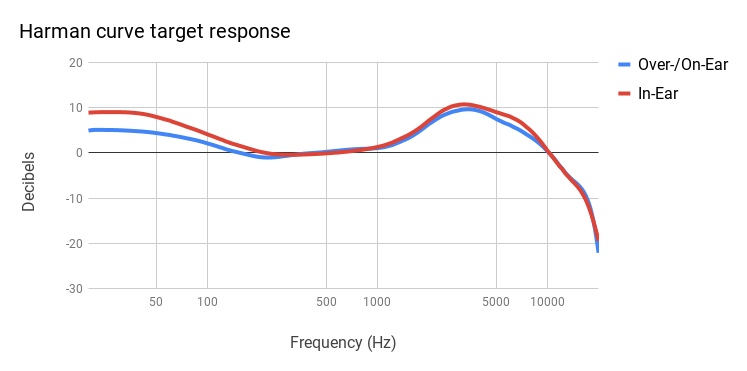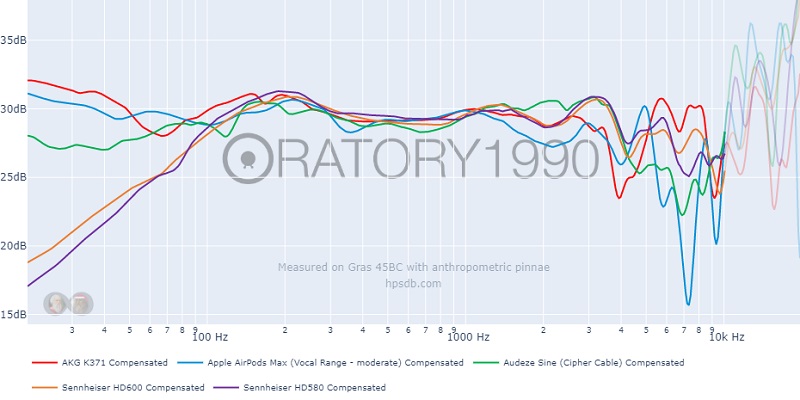ADUHF
Headphoneus SupremusMusic And Measurements
I don't know if you noticed this btw, but the target response curve that AutoEQ uses for its Rtings graphs looks a bit different in the treble than the target Rtings is currently using for its own compensated frequency plots.
I believe Jaakko computed his Rtings target by comparing the measurements of several headphones in both the Oratory1990 and Rtings databases. And then modifying the Harman target accordingly. A notable feature of the AutoEQ Rtings target is the rather pronounced peak at 9 kHz, which is almost as high as the peak at 3 kHz. That is a feature you will often see in the Rtings measurements. Though the height of that peak can vary quite a bit.
On my 250 ohm Beyer DT-770's, for example, the peak at 9k is several dBs higher than the AutoEQ target curve, which is shown in light blue...
https://github.com/jaakkopasanen/AutoEq/tree/master/results/rtings/rtings_harman_over-ear_2018/Beyerdynamic DT 770 250 Ohm
While on some of the more popular Sennheisers, it's several dBs lower than the AutoEQ target...
https://github.com/jaakkopasanen/AutoEq/tree/master/results/rtings/rtings_harman_over-ear_2018/Sennheiser HD 650
https://github.com/jaakkopasanen/AutoEq/tree/master/results/rtings/rtings_harman_over-ear_2018/Sennheiser HD 600
https://github.com/jaakkopasanen/AutoEq/tree/master/results/rtings/rtings_harman_over-ear_2018/Sennheiser HD 58X
It is a closer match though on a headphone like the AKG K371...
https://github.com/jaakkopasanen/AutoEq/tree/master/results/rtings/rtings_harman_over-ear_2018/AKG K371
The M40x is also not a bad match at that particular frequency, but it stays brighter above 9 kHz than the target. And is also a bit too withdrawn in the lower midrange...
https://github.com/jaakkopasanen/AutoEq/tree/master/results/rtings/rtings_harman_over-ear_2018/Audio-Technica ATH-M40x
Compare the response of the M40x to the Senn 58X above, which seems to follow the AutoEQ target better in the upper treble between 10 and 20 kHz.
I'm not sure a headphone needs to be quite as bright in that 9 kHz range as the AutoEQ Rtings target suggests, to sound good. But maybe the lack of volume in that general area is one of the things which contributes to some Sennheisers having a slightly "veiled" quality. I suspect that Sennheiser tuned some of their headphones that way intentionally, btw, to take a bit of the edge off of their sound in that frequency range.
The Shure SRH440 also follows that AutoEQ target pretty well in the treble and upper mids, including around 9k. So perhaps that's why Crinacle gave it such a high rank (for a lower cost HP) on his list of best headphones. The 440 is pretty rolled off in the bass for a closed HP though. And the peak at 3k appears slightly higher relative to the target curve than the peak at 3 kHz. So I suspect it might come across a little on the bright side....
https://github.com/jaakkopasanen/AutoEq/tree/master/results/rtings/rtings_harman_over-ear_2018/Shure SRH440
It looks maybe a little too forward in the upper mids between 1k and 2k as well. Which is an area where my ears seem to be particularly sensitive. But overall it's doin a fairly good job of tracking the AutoEQ curve, except in the lower bass.
I believe Jaakko computed his Rtings target by comparing the measurements of several headphones in both the Oratory1990 and Rtings databases. And then modifying the Harman target accordingly. A notable feature of the AutoEQ Rtings target is the rather pronounced peak at 9 kHz, which is almost as high as the peak at 3 kHz. That is a feature you will often see in the Rtings measurements. Though the height of that peak can vary quite a bit.
On my 250 ohm Beyer DT-770's, for example, the peak at 9k is several dBs higher than the AutoEQ target curve, which is shown in light blue...
https://github.com/jaakkopasanen/AutoEq/tree/master/results/rtings/rtings_harman_over-ear_2018/Beyerdynamic DT 770 250 Ohm
While on some of the more popular Sennheisers, it's several dBs lower than the AutoEQ target...
https://github.com/jaakkopasanen/AutoEq/tree/master/results/rtings/rtings_harman_over-ear_2018/Sennheiser HD 650
https://github.com/jaakkopasanen/AutoEq/tree/master/results/rtings/rtings_harman_over-ear_2018/Sennheiser HD 600
https://github.com/jaakkopasanen/AutoEq/tree/master/results/rtings/rtings_harman_over-ear_2018/Sennheiser HD 58X
It is a closer match though on a headphone like the AKG K371...
https://github.com/jaakkopasanen/AutoEq/tree/master/results/rtings/rtings_harman_over-ear_2018/AKG K371
The M40x is also not a bad match at that particular frequency, but it stays brighter above 9 kHz than the target. And is also a bit too withdrawn in the lower midrange...
https://github.com/jaakkopasanen/AutoEq/tree/master/results/rtings/rtings_harman_over-ear_2018/Audio-Technica ATH-M40x
Compare the response of the M40x to the Senn 58X above, which seems to follow the AutoEQ target better in the upper treble between 10 and 20 kHz.
I'm not sure a headphone needs to be quite as bright in that 9 kHz range as the AutoEQ Rtings target suggests, to sound good. But maybe the lack of volume in that general area is one of the things which contributes to some Sennheisers having a slightly "veiled" quality. I suspect that Sennheiser tuned some of their headphones that way intentionally, btw, to take a bit of the edge off of their sound in that frequency range.
The Shure SRH440 also follows that AutoEQ target pretty well in the treble and upper mids, including around 9k. So perhaps that's why Crinacle gave it such a high rank (for a lower cost HP) on his list of best headphones. The 440 is pretty rolled off in the bass for a closed HP though. And the peak at 3k appears slightly higher relative to the target curve than the peak at 3 kHz. So I suspect it might come across a little on the bright side....
https://github.com/jaakkopasanen/AutoEq/tree/master/results/rtings/rtings_harman_over-ear_2018/Shure SRH440
It looks maybe a little too forward in the upper mids between 1k and 2k as well. Which is an area where my ears seem to be particularly sensitive. But overall it's doin a fairly good job of tracking the AutoEQ curve, except in the lower bass.
Last edited:





































